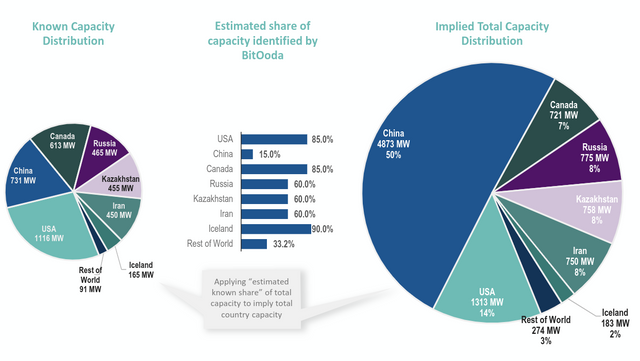The new crypto research report claims that China has 50% of the world’s hash power only, but the US has 14%. This message is in stark contrast to the earlier report.
According to the University of Cambridge Centre for Alternative Finance (CCAF) China accounts for 65% of the total Bitcoin hash power and the US accounts about 7,2%.
The BitOoda team with the Fidelity Center for Applied Technology (FCAT) support has published research about bitcoin mining hashrate at the July 15. The one of the main target of the report is identification regions with the largest Bitcoin hash power. BitOoda points private interviews with a miners, manufacturers and dealers of ASICs as a one kind of sources of the research report.
We were able to locate ~4.1GW of power across 153 mining sites, including 67 sites or ~3GW power capacity, with power price data provided upon condition of anonymity.
We estimate China accounts for about 50% of global capacity, while the US follows with about 14%.
The information about 50% part of China has a big difference with CCAF data. And if BitOoda is right then China influence on the mining part of bitcoin is greatly exaggerated. And the second conclusion: the US is growing fast as a mining center.
But China has the first place in the mining power rating and its influence is the greatest among all countries of the world in any case.

So the thirds place (after China and the US) belongs to Russia, Kazakhstan and Iran (each have 8%). Canada has 7%, Iceland — 2%, rest world — 3%.
50% of Bitcoin mining capacity pays 3c or less per kWh, a steady decline over the past several years. Anecdotal evidence suggests this number was closer to 6c / kWh in 2018.
The average cost to mine 1 BTC is about $5000. This estimate is cash operating expense and does not include depreciation or other costs for mining hardware.
A significant portion of Chinese capacity migrates in Sichuan and Yunnan to take advantage of lower power prices during the flood season (May — October). Miners pay sub-1c / kWh only during the wet season instead of 2.5–3c / kWh in northern China during the dry months.
In our view, the flood or hydro season shifts the cost curve down for 6 months of the year, leading to lower sales of Bitcoin to fund operating expenses as miners accumulate capital to fund capacity growth.
So probably we have wait the end of the wet season to watch the great growing of bitcoin price. And don’t forget that the wet season can be finished in any month from August to October.
it so strange Chile has a lot very cheap electricity but where are chile miners?
Downvoting a post can decrease pending rewards and make it less visible. Common reasons:
Submit